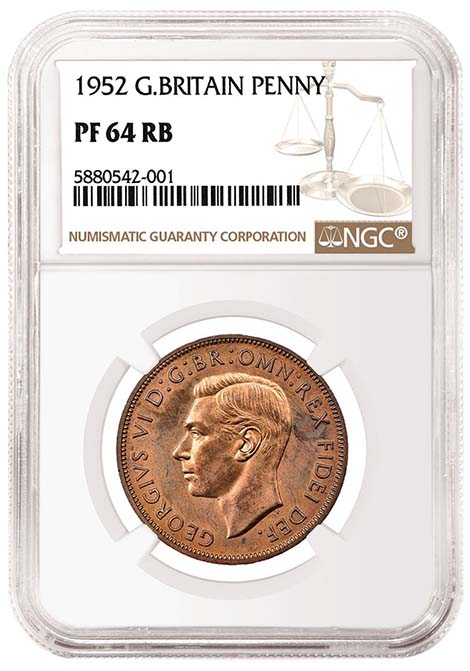 In Great Britain, the year 1952 saw a change of monarch, the first home-use microwave oven and the Great Smog of London, but nothing so common as a penny issued by the Royal Mint. Only one Great Britain penny is believed to have been struck in 1952, and it was recently certified by Numismatic Guaranty Corporation® (NGC®).
In Great Britain, the year 1952 saw a change of monarch, the first home-use microwave oven and the Great Smog of London, but nothing so common as a penny issued by the Royal Mint. Only one Great Britain penny is believed to have been struck in 1952, and it was recently certified by Numismatic Guaranty Corporation® (NGC®).
 The unique 1952 Great Britain Penny was submitted to NGC International UK Limited (NGC UK), the London affiliate of NGC, by Sovereign Rarities, a leading London-based coin dealer. Established in 2018 to better serve collectors and dealers in the UK, NGC UK has already received and certified many important British numismatic rarities, including a 1937 Edward VIII Bronze Pattern Penny and a unique 1808 Soho Penny from the Waterbird Collection.
The unique 1952 Great Britain Penny was submitted to NGC International UK Limited (NGC UK), the London affiliate of NGC, by Sovereign Rarities, a leading London-based coin dealer. Established in 2018 to better serve collectors and dealers in the UK, NGC UK has already received and certified many important British numismatic rarities, including a 1937 Edward VIII Bronze Pattern Penny and a unique 1808 Soho Penny from the Waterbird Collection.
 Now graded NGC PF 64 RB, the unique 1952 Great Britain Penny features George VI, who died the same year. His daughter, Queen Elizabeth II, assumed the responsibilities of ruling monarch, and her portrait was introduced to British coinage in 1953.
Now graded NGC PF 64 RB, the unique 1952 Great Britain Penny features George VI, who died the same year. His daughter, Queen Elizabeth II, assumed the responsibilities of ruling monarch, and her portrait was introduced to British coinage in 1953.
 However, the ascension of Elizabeth to the throne was not the reason the Royal Mint nixed the production of George VI pennies in 1952. Rather, there were already a large number of pennies in circulation, and it remained that way throughout the 1950s. Until 1961, the only British pennies minted were a small amount of 1950 and 1951 pennies mostly sent to the colonies, specimen sets issued for the Queen's Coronation in 1953 and another unique example - a 1954 penny struck for internal Royal Mint purposes.
However, the ascension of Elizabeth to the throne was not the reason the Royal Mint nixed the production of George VI pennies in 1952. Rather, there were already a large number of pennies in circulation, and it remained that way throughout the 1950s. Until 1961, the only British pennies minted were a small amount of 1950 and 1951 pennies mostly sent to the colonies, specimen sets issued for the Queen's Coronation in 1953 and another unique example - a 1954 penny struck for internal Royal Mint purposes.
 The overall decrease in the demand for British pennies, which started in the late 1940s and created the circulating surplus in the 1950s, was largely due to two factors. First, the lighter, more convenient brass threepence coin became more popular than the penny. Second, inflation dramatically reduced the penny's purchasing power. The Royal Mint redeemed surplus pennies from banks for melting starting in 1951, and by the end of the decade, about £1.2 million worth had been removed from circulation.
The overall decrease in the demand for British pennies, which started in the late 1940s and created the circulating surplus in the 1950s, was largely due to two factors. First, the lighter, more convenient brass threepence coin became more popular than the penny. Second, inflation dramatically reduced the penny's purchasing power. The Royal Mint redeemed surplus pennies from banks for melting starting in 1951, and by the end of the decade, about £1.2 million worth had been removed from circulation.
 Thus, any British penny from the 1950s is rare, but as the sole example of its date, the 1952 penny is an extremely significant numismatic and historical artifact. Its authentication and preservation are essential.
Thus, any British penny from the 1950s is rare, but as the sole example of its date, the 1952 penny is an extremely significant numismatic and historical artifact. Its authentication and preservation are essential.
 Steven Eichenbaum, NGC CEO, commented: "We are thrilled that our newest location in London has enabled us to certify amazing British rarities such as this unique 1952 penny. We look forward to continuing to serve the UK market and to doing all we can to ensure that important coins are recognized and protected."
Steven Eichenbaum, NGC CEO, commented: "We are thrilled that our newest location in London has enabled us to certify amazing British rarities such as this unique 1952 penny. We look forward to continuing to serve the UK market and to doing all we can to ensure that important coins are recognized and protected."
 "Very few coins are unique," said Ian Goldbart, Founder of Sovereign Rarities, "so being part of the story of the 1952 penny is a once-in-a-lifetime role. NGC UK made it very convenient for us to have this coin certified and preserved for posterity."
"Very few coins are unique," said Ian Goldbart, Founder of Sovereign Rarities, "so being part of the story of the 1952 penny is a once-in-a-lifetime role. NGC UK made it very convenient for us to have this coin certified and preserved for posterity."



